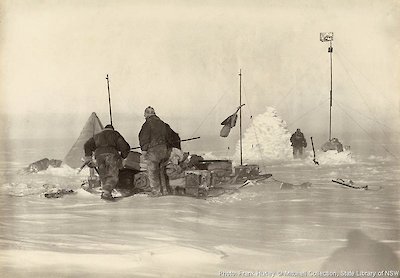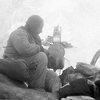On the knife-edge
The journey home for the Southern Party began as a stop-start affair, with spectacularly rapid progress interspersed with infuriating stoppages owing to weather. In white-out conditions they were increasingly bothered by snow-blindness, afflicting Hurley and, more seriously, Bage, who had to ride on the sledge early in January.
But their most serious concern was food. With dwindling supplies they needed to find the depot laid down by their support team in November. They reached the depot’s latitude, but needed a sun sighting to calculate longitude, and the sun had been hidden in white-out conditions for days. They did not know whether the depot was to their east or west, and lost three days in a fruitless search.
Things had become desperate by 7 January, with the sun still invisible, Cape Denison over 100 kilometres away and only a day of their quarter-rations left. ‘If we stay here and the weather does not clear we starve miserably,’ wrote Hurley in his diary. ‘In my opinion we are as good as dead, if we decide on this latter course.’ He tried to convince his comrades to make the dash, but they voted to stay in the hope that the sun would appear and enable them to find the depot.
The sun finally appeared on the morning of 8 January, but before they could get their sight it disappeared behind a cloud and gave no sign of coming out again. ‘We looked at each other and neither spoke,’ wrote Hurley:
We were all unanimous now that it was the only thing to be done, a dash for the Hut … We are resolved to make the hut or perish. This trifling ration … is insufficient to keep warmth in us [but] there is no alternative … Fortunately we are three hefty and stout hearted individuals.
With the sun remaining obstinately hidden, the southerly wind was their only directional guide. They struggled through blinding drift snow, often unable to see a metre ahead, for a day. Even the irrepressible Hurley was downcast, wracked with worry and guilt:
I have been trying to cheer up my companions, but can’t say I like our present prospect … My comrades are fine men and breathe no pessimism. If we don’t reach the Hut I will feel myself to blame as I was so eager to push off on this hazardous endeavour.
Then late in the evening the sky cleared and they saw the distant ocean, ‘littered with innumerable icebergs — lit by the low evening sun, glowing pink’. They calculated Cape Denison was about 50 kilometres away, but they could not see it and still did not know whether to go east or west. Next morning they decided to go eight kilometres west.
Struggling through heavily crevassed country, at last they recognised the ice cliffs of Commonwealth Bay and the McKellar Islets. Bage, in his excitement, stepped into a large crevasse, saved only by his sledging harness and the efforts of his companions. They retraced their steps to go around the heavily crevassed area, and after a time found Aladdin’s Cave, a mere eight kilometres from Cape Denison.
What touched us most [wrote Hurley] was the hand grip we gave each other and the sight of some dog biscuits, on which we made a hasty start. We crawled into the Five Mile Excavation, and after a Hoosh [a heated stew of pemmican], slept sounder and happier than we had done for many months.
Looking back, [wrote Webb] I don’t know how on earth we did it … [through] those two blank, dark days, when we fell or scrambled along to we knew not what end … ’
It remained only to slip and slide the short distance down the ice to the Hut, hauling ‘poor Bob’ — snow-blinded Bage — on the sledge. At 5pm on 10 January, wrote Hurley:
… we came down the long ice slope at the back of the hut. Those in the hut came running out cheering. We had a Royal reception and were carried into the Hut where Good Old Close had a banquet prepared for us.


